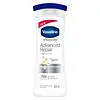What's inside
What's inside
 Key Ingredients
Key Ingredients

No key ingredients
 Benefits
Benefits

 Concerns
Concerns

 Ingredients Side-by-side
Ingredients Side-by-side

Allantoin 0.5%
Skin ConditioningAloe Barbadensis Leaf Juice Powder
Skin ConditioningButyrospermum Parkii Oil
EmollientCaprylyl Glycol
EmollientCaprylyl/Capryl Glucoside
CleansingCitric Acid
BufferingGlycerin
HumectantGlycine Soja Oil
EmollientHelianthus Annuus Seed Oil
EmollientMethylpropanediol
SolventPanthenol
Skin ConditioningPantolactone
HumectantPhenoxyethanol
PreservativePolyisobutene
Sodium Acrylate/Sodium Acryloyldimethyl Taurate Copolymer
Emulsion StabilisingSorbitan Oleate
EmulsifyingTocopherol
AntioxidantWater
Skin ConditioningAllantoin 0.5%, Aloe Barbadensis Leaf Juice Powder, Butyrospermum Parkii Oil, Caprylyl Glycol, Caprylyl/Capryl Glucoside, Citric Acid, Glycerin, Glycine Soja Oil, Helianthus Annuus Seed Oil, Methylpropanediol, Panthenol, Pantolactone, Phenoxyethanol, Polyisobutene, Sodium Acrylate/Sodium Acryloyldimethyl Taurate Copolymer, Sorbitan Oleate, Tocopherol, Water
Water
Skin ConditioningGlycerin
HumectantPetrolatum
EmollientCarbon
Stearic Acid
CleansingGlycol Stearate
EmollientTriethanolamine
BufferingDimethicone
EmollientEthyl Isopropyl-Bicycloheptene-2-Carboxylate
PerfumingTapioca Starch
Cetyl Alcohol
EmollientGlyceryl Stearate
EmollientMagnesium Aluminum Silicate
AbsorbentMethylparaben
PreservativePhenoxyethanol
PreservativePropylparaben
PreservativeDisodium EDTA
Titanium Dioxide
Cosmetic ColorantWater, Glycerin, Petrolatum, Carbon, Stearic Acid, Glycol Stearate, Triethanolamine, Dimethicone, Ethyl Isopropyl-Bicycloheptene-2-Carboxylate, Tapioca Starch, Cetyl Alcohol, Glyceryl Stearate, Magnesium Aluminum Silicate, Methylparaben, Phenoxyethanol, Propylparaben, Disodium EDTA, Titanium Dioxide
Ingredients Explained
These ingredients are found in both products.
Ingredients higher up in an ingredient list are typically present in a larger amount.
Glycerin is already naturally found in your skin. It helps moisturize and protect your skin.
A study from 2016 found glycerin to be more effective as a humectant than AHAs and hyaluronic acid.
As a humectant, it helps the skin stay hydrated by pulling moisture to your skin. The low molecular weight of glycerin allows it to pull moisture into the deeper layers of your skin.
Hydrated skin improves your skin barrier; Your skin barrier helps protect against irritants and bacteria.
Glycerin has also been found to have antimicrobial and antiviral properties. Due to these properties, glycerin is often used in wound and burn treatments.
In cosmetics, glycerin is usually derived from plants such as soybean or palm. However, it can also be sourced from animals, such as tallow or animal fat.
This ingredient is organic, colorless, odorless, and non-toxic.
Glycerin is the name for this ingredient in American English. British English uses Glycerol/Glycerine.
Learn more about GlycerinPhenoxyethanol is a preservative that has germicide, antimicrobial, and aromatic properties. Studies show that phenoxyethanol can prevent microbial growth. By itself, it has a scent that is similar to that of a rose.
It's often used in formulations along with Caprylyl Glycol to preserve the shelf life of products.
Water. It's the most common cosmetic ingredient of all. You'll usually see it at the top of ingredient lists, meaning that it makes up the largest part of the product.
So why is it so popular? Water most often acts as a solvent - this means that it helps dissolve other ingredients into the formulation.
You'll also recognize water as that liquid we all need to stay alive. If you see this, drink a glass of water. Stay hydrated!
Learn more about Water